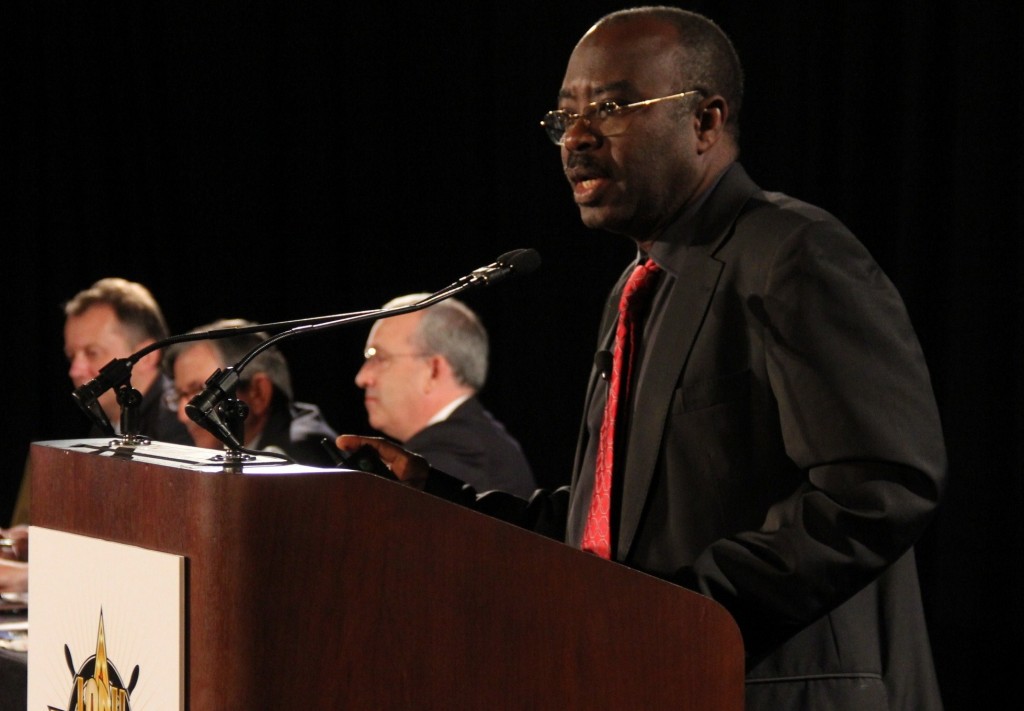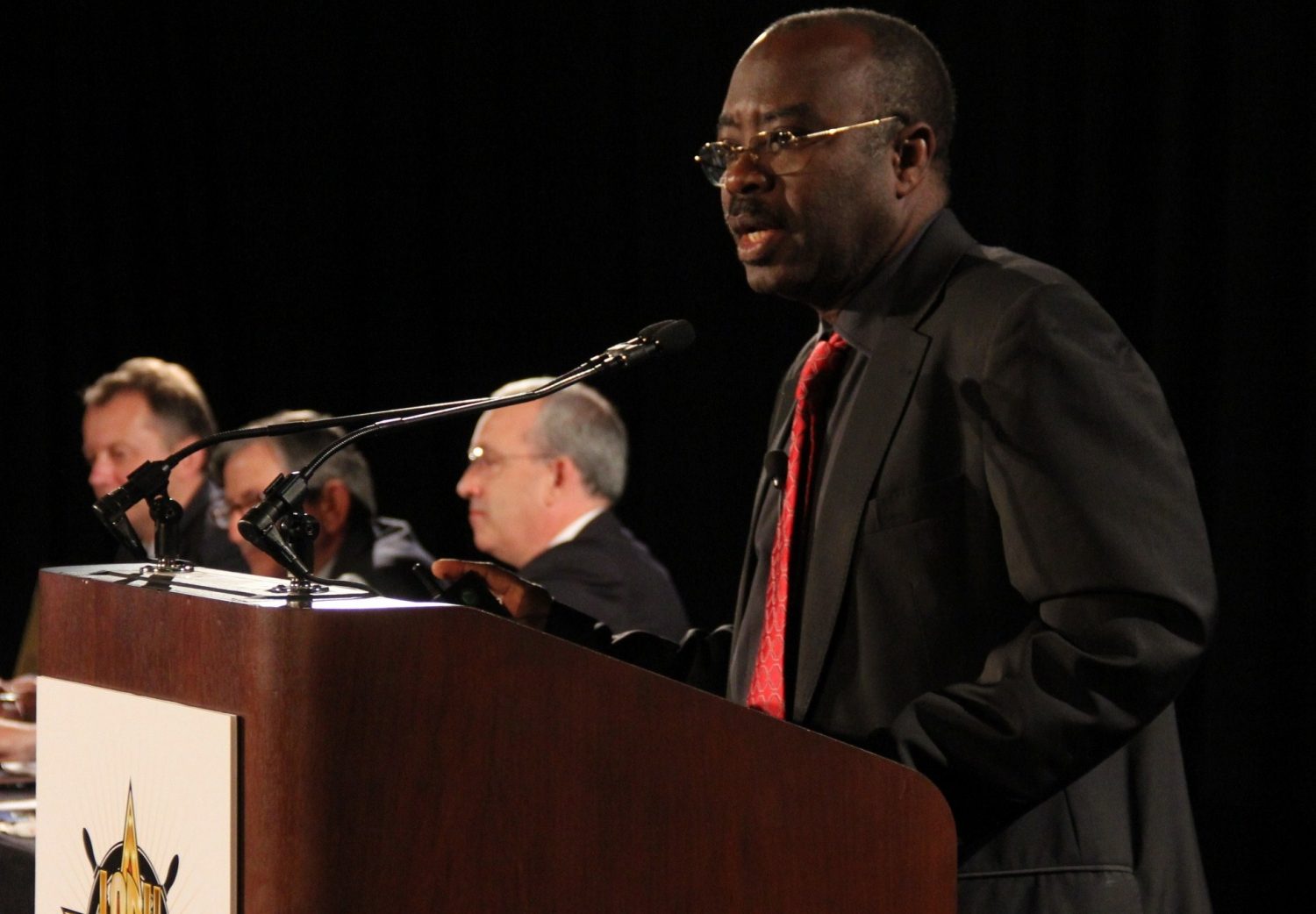The Cotonou Port on the world’s stage in Los Angeles
SPONSORED MATERIAL

The International Association of Ports and Harbors, I.A.P.H., a non-governmental organization dedicated to promoting the interest of ports worldwide through strong member relationships, collaboration and information-sharing, held its 28th World Ports Conference in the busy downtown area of LA Live, in Los Angeles, California May 5-10. The high-profile gathering, held in the upscale J.W. Marriott Hotel, brought together ports’ leaders from across the world to discuss timely and important topics of interest to the industry, under the overall theme of “Working on Today, Focusing on Tomorrow.” It also featured exhibitions from leading global companies and cultures.
Richard Phillips, captain of the Maersk Alabama hijacked by Somali pirates a few years ago, kicked off the sessions with a much-anticipated keynote speech about his experience as a hostage. Then followed several days of informative sessions featuring prominent speakers who addressed topics including, but not limited to, the following: Piracy and efforts to curb piracy; Best practices in port finance; The emergence of LNG-powered vessels and handling/transport through ports; Global warming and climate change; Port Community Systems, and Advancing women in the port and maritime industries.
Addressing the conference participants on the important issue of Port Community System, Kassim Traoré, the director-general of the Cotonou Port – the only African port manager present – shared with his peers the experience of his West African institution.
In an exclusive interview with The African upon the conclusion of the conference, The Cotonou Port’s director-general summarized his company’s attendance as follows: “The conference went very well. It was a great opportunity to share information with peers in the field. As you know, The Cotonou Port, of which I have the honor to be the director-general, was honored with a medal. I must tell you this gold medal means a lot to us, a small port among the big ones. It is an encouragement for us to do even better. We are humbled.”
Importance of the Cotonou Port for the National Economy
The Cotonou Port became operational in 1965 and is equipped with the infrastructure necessary for trading with the rest of the world. It plays a crucial role in the economy of Benin, and is often referred to by the authorities as “the backbone” of the nation’s economy. Indeed, 90% of Benin’s trade is achieved by sea. The Benin state derives 40% to 50% of its revenue from the port sector. 80% to 85% of customs revenue is generated by The Cotonou Port.
The Cotonou Port also carries a strategic weight in the West African region. It is located approximately half-way between the Lagos Port (115 kilometers away) and the Lome Port (135 kilometers away). It is exceptionally well-situated to serve the landlocked countries in West Africa (Niger, Burkina Faso and Mali). The Cotonou Port is also the fastest relay and transshipment port toward Nigeria and Niger’s first transit. To a lesser extent, the Cotonou Port serves as the maritime access for other Sahelian countries such as Chad in the Central African region.
The port’s crucial role in the economy of Benin accounts for the head of state, Yayi Boni keeping a close eye on its operations, sometimes stepping in to steer it in the right direction.
Several years ago, The Cotonou Port embarked on a modernization process to ensure that its users and partners get a quality of service that meets their legitimate requirements. A series of reforms and extensive construction works went underway to foster competition at the port. In the process, short-term, mid-term and long-term investments via a public/private sector partnership were made to speed up the loading and unloading operations, beef up security, among other things.
Major recent accomplishments
Recent major accomplishments at the Cotonou Port, which are in line with the strategic orientation of the government, lie in the various reforms aimed at facilitating trade; the handling of the recently-observed congestion in the port area; the easing of vessels’ operations and goods-handling, and the provision of adequate security; and the Port’s financial support for the development of the nation.
Notable among the reforms aimed at facilitating trade are the Port One-Stop Window (GUP), The Integrated Management System of the Cotonou Port (SIGPAC), and the Imports Verification Program, new generation (PVI), a new system designed to facilitate the customs clearance of goods.
The SIGPAC, funded by the Millennium Challenge Account, involves the acquisition of IT equipment to strengthen the existing IT capability; the installation of a video surveillance system to control access to the Port and ensure fire prevention. Though completed at the end of 2011, the system is yet to enter the operational phase.
Owing to the controversy that it triggered, the Imports Verification Program, new generation (PVI) was put on hold by the government for the purpose of improving it.
The GUP was officially launched by the head of state in person on October 11, 2011. It’s a crucial, money-saving and time-saving mechanism that allows Port patrons to carry out in one place multiple transactions that used to require going to different windows. It comes as a notable improvement of efficiency in the entire port logistical chain. The automation of the procedures allows a quicker passage of the goods, not to mention that it increases the transparency of the transactions, thereby helping secure and hike fiscal and customs revenues. The GUP came to life thanks to the contribution of various other entities operating at the port, including, besides The Cotonou Port itself, the Benin Customs Services, the Benin National Council of Shippers (CNCB), the Benin State-Owned Company for Goods Handling (SOBEMAP), the Benin Chamber of Commerce, only to mention these.
In his power-point presentation at the IAPH conference in Los Angeles, the Cotonou Port director-general’s pride in his institution, with a special emphasis on the GUP, was all-too obvious: “Thanks to the successful completion of the One-Stop Window and the modernization of its infrastructure, the Cotonou Port now has the precious tools necessary to really play its role as the lungs of the Benin economy and that of a port with regional stature.” The top boss at the port added: “Owing to the tangible results achieved, which translate to the increase of operational productivity and a notable improvement of performance, The Cotonou Port, the flagship of the community port system in Sub-Sahara Africa thanks to the “Escale” program, is poised, as of August 2011, to become the pioneer in the installation of a successful Port One-Stop Window, with a Single Fee Schedule and a single payment which have become reality.”


